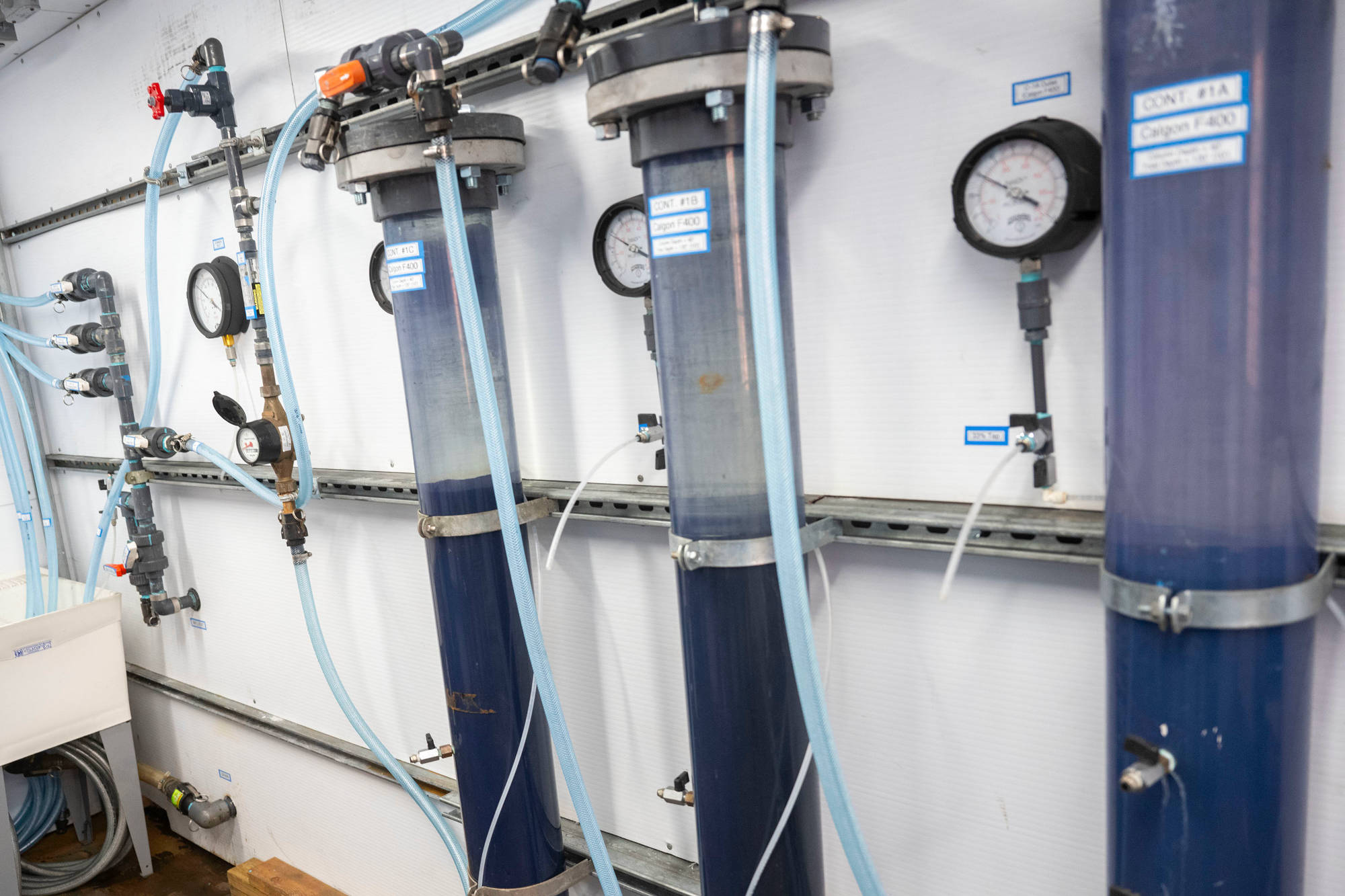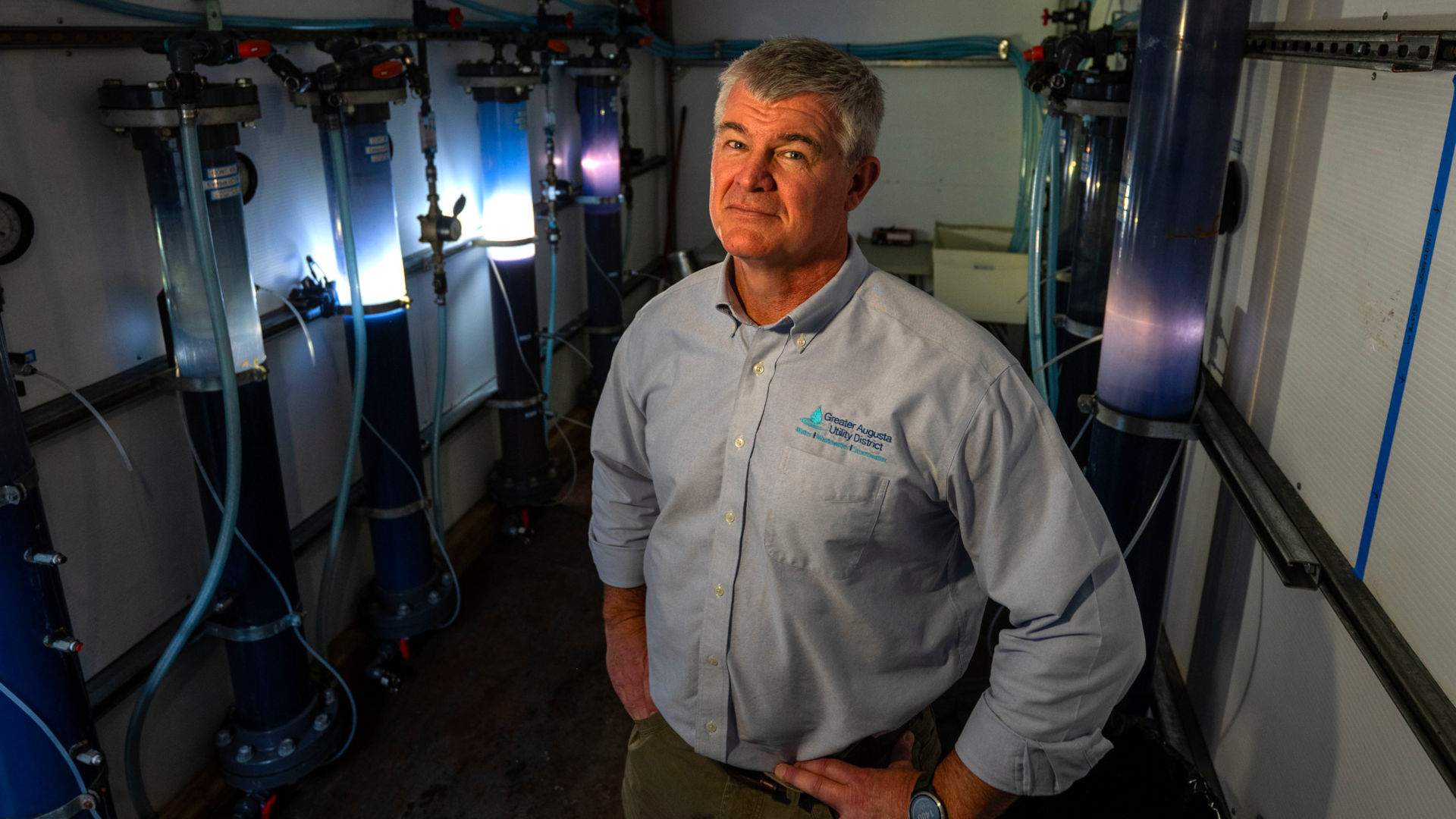The Cost of Freeing Drinking Water from ‘Forever Chemicals’
Situated in a former sand and gravel pit just a few hundred feet from the Kennebec River in central Maine, the Riverside Station pumps half a million gallons of fresh groundwater every day. The well station processes water from two of five wells on either side of the river operated by the Greater Augusta Utility District, or GAUD, which supplies drinking water to nearly 6,000 local households. Most of them reside in Maine’s state capital, Augusta, just a few miles to the south. Ordinarily, GAUD prides itself on the quality of its water supply. “You could drink it out of the ground and be perfectly safe,” said Brian Tarbuck, GAUD’s general manager.
But in March 2021, environmental sampling of Riverside well water revealed trace levels of per- and polyfluoroalkyl substances (PFAS), or “forever chemicals,” as they’re better known. The levels at Riverside didn’t exceed Maine’s drinking water standard of 20 parts per trillion (ppt), which was a relief, Tarbuck said. Still, he and his colleagues at the utility were wary. PFAS have been linked to a variety of health problems, and Maine lawmakers at the time were debating an even stricter limit for the chemicals. Tarbuck knew a lower standard was coming someday. The only question was when.
As it turns out, a tougher standard is expected early this year. That’s when the U.S. Environmental Protection Agency is set to finalize an enforceable cap on PFAS in drinking water that will require GAUD and thousands of other utilities around the country to update their treatment methods. The standard, which in regulatory terms is called a maximum contaminant level or MCL, limits permissible amounts of the two most studied and ubiquitous PFAS compounds — PFOA and PFOS — to just 4 ppt in drinking water each. Roughly equivalent to a single drop in five Olympic-size swimming pools, this is the lowest concentration that current analytical instruments can reliably detect “within specific limits of precision and accuracy during routine laboratory operating conditions,” according to the EPA. Four other PFAS — PFHxS, PFNA, PFBS, and HFPO-DA, which along with a related chemical is sometimes referred to by the trade name GenX — will be regulated by combining their acceptable levels into a single value. Utilities will have three to five years to bring their systems into compliance.


Agency officials estimate that between 3,400 and 6,300 water systems will be affected by the regulation, which is the EPA’s first ever PFAS standard and the first MCL set by the agency for any chemical in drinking water in over 25 years. PFOA and PFOS account for the majority of anticipated exceedances.
GAUD is now gearing up to spend $3 to 5 million on PFAS removal technology, according to Tarbuck, much of which will be passed on to its customers in the form of higher water bills. Nationally, the price tag of meeting the standard could top $37 billion in upfront costs, in addition to $650 million in annual operating expenses, according to the American Water Works Association, or AWWA, a nonprofit lobbying group representing water utilities. That’s far higher than the EPA’s cost estimate of $777 million to $1.2 billion and a significant burden for an industry already contending with other costly priorities, such as boosting cybersecurity and “replacing all those antiquated, leaking big water pipes that transport the water from the treatment plant to the service line” that connect to homes, said Marc Edwards, a professor of civil and environmental engineering at Virginia Tech. Chris Moody, the AWWA’s regulatory technical manager, said most of the money will be spent in the next several years, as utilities race to install PFAS removal systems and other infrastructure needed to meet compliance deadlines.
In proposing the limits, EPA officials said that they had leveraged the latest science to protect the public from PFAS pollution. Environmental groups welcomed the move as long overdue. But the standard has drawn widespread criticism from the water utility industry and some scientists who say that in many places, small drops in PFAS water levels will matter little for exposure or health. “There are other strategies that get us to safer, public health protective approaches to PFAS that don’t involve the really strict standard that EPA is putting forward,” said Ned Calonge, an associate dean for public health practice at the Colorado School of Public Health and chair of a 2022 National Academies of Sciences report on PFAS exposure, testing, and clinical follow-up.
EPA officials estimate that between 3,400 and 6,300 water systems will be affected by the regulation, which is the agency’s first ever PFAS standard.
A key issue, critics say, is that the standard ensnares too many utilities with very small PFAS exceedances. Roughly 98 percent of drinking water utilities in the country, including GAUD, have maximum PFOA and PFOS levels below 10 ppt, according to the AWWA. When the levels are already so low, further reductions of a few parts per trillion “is not going to have much effect on total exposure intake,” wrote Ian Cousins, an environmental chemist at Stockholm University and one of the world’s leading researchers on PFAS exposure, in an email to Undark.
Drinking water is only one among many different pathways by which people can be exposed to PFAS. The chemicals are also in agricultural produce, fish, meat, outdoor soil, household dust, nonstick cookware, cosmetics, fast-food wrappers, stain- and water-resistant fabrics, and other products. Just how much these sources each contribute to PFAS exposure is a subject of ongoing research. But the EPA estimates that Americans get 80 percent of their PFAS intake from sources other than drinking water, and according to Cousins, dietary contributions likely account for most human exposure. The U.S. Food and Drug Administration has required the phase out of some PFAS in food packaging. But “food is contaminated via bioaccumulation in agricultural and marine food chains,” Cousins said. “We cannot clean up our food in the same way that we can add a treatment process to our drinking water.”

Environmental chemist Ian Cousins is one of the world’s leading researchers on PFAS exposure.
Visual: Courtesy of Ian Cousins
Yet another point of contention has to do with EPA’s methods in deriving the new limits. Scientists broadly disagree over how PFAS affect human health. Jamie DeWitt, a professor of environmental and molecular toxicology at Oregon State University who also sat on the EPA’s PFAS review panel and has appeared as an expert witness for plaintiffs in PFAS cases, emphasized that evidence from different studies links the chemicals with cancer, as well as higher cholesterol levels, elevated enzymes associated with liver damage, and reduced birth weights. Much of that evidence comes from studies of people who were highly exposed under occupational settings, or who lived near sites where the chemicals were routinely discharged into the environment.
But evidence linking the effects to trace PFAS levels is “less convincing,” said Alan Boobis, emeritus professor of toxicology at Imperial College London. Meanwhile, the EPA errs on the side of extreme caution, while health agencies elsewhere in the world apply less conservative assumptions to their own PFAS regulations. The World Health Organization, for instance, citing what it describes as “significant uncertainties and absence of consensus” over critical PFAS health endpoints, recently set a provisional guideline that limits PFOA and PFOS to a higher value of 100 ppt in drinking water and 500 ppt for all other measurable PFAS. In Australia, the drinking water PFOA guideline is 560 ppt.
Moody said neither grant programs nor settlements from litigation against PFAS manufacturers will fully cover the anticipated cost of complying with the EPA’s new standard. Some funding could be made available through recently proposed settlements with 3M and other PFAS manufacturers worth up to nearly $11.5 billion. But the pay to any one water system is limited, and utilities that opt out of the settlements might wait years to resolve their own cases.
Moody’s association says that the costs of building and operating PFAS treatment systems will be borne mainly by consumers. The AWWA’s estimated rate hikes range from $305 to $3,570 per household — and could be even higher. According to Moody, the smallest communities will pay the most, since fewer households share in the total cost.
Given the “huge amount of money to comply to these guidelines,” Cousins argued that the public might be better served by a policy that prioritizes hot spots of PFAS contamination. “That would make sense from my point of view,” he said in an email. “There needs to be some pragmatism built into the regulatory process so that the limited money can be spent on the worst contamination cases first.”
First created in the 1930s, PFAS were later developed for commercial use during the 1940s by companies including the Minnesota Mining and Manufacturing Company, later renamed 3M. Made from a carbon backbone entwined with atoms of fluorine, the chemicals deflect water, grease, and heat and have been produced in industrial quantities for decades. PFOA and PFOS were among the first of thousands of different PFAS produced to reach the market. Used to manufacture products such as Teflon, Gore-Tex, Scotchgard fabric protectors, fire-fighting foams, and microchips, the two compounds are dubbed long-chain PFAS because their backbones contain eight carbon atoms.
Unfortunately, the same properties that make PFAS commercially useful also make them stubbornly persistent. The carbon-fluorine bond is one of the strongest in organic chemistry. PFAS resist environmental degradation and metabolism by nearly all living creatures. The most contaminated sites occur near manufacturing facilities or sites where historic PFASs were heavily used before they were phased out. For instance, groundwater sampled at wells adjacent to an industrial tannery in Rockford, Michigan, operated by a company called Wolverine World Wide, contained PFOA and PFOS at combined levels higher than 75,000 ppt. But PFAS circulate in the global atmosphere, and the chemicals have been detected as far afield as Antarctica and the Tibetan plateau, deposited there by rain and snow.
Tarbuck said he isn’t sure how the wells at Riverside Station in Maine became contaminated. “Because these numbers are so incredibly small, it’s hard to pinpoint,” he said. “It’s a head-scratcher.” The site is located far from any industrial sources, but sampling has shown slightly elevated PFAS in the Kennebec, possibly originating from contaminated sludge used as fertilizer by upstream farms. “We believe that the PFAS is coming from the river,” Tarbuck said.

In 2003, the U.S. Centers for Disease Control and Prevention published sampling results suggesting that nearly all Americans had measurable amounts of PFAS in their blood. Published studies had by that time associated PFOA and PFOS with liver disease, reproductive problems, and cancer in laboratory animals, and one study suggested a link between PFOS and human bladder cancer, but only among workers who were exposed to high levels on the job for at least five years. More recent evidence associates PFOA and PFOS with testicular and kidney cancers, and based on these results, the EPA now classifies both compounds as likely human carcinogens.
Internal industry documents show that 3M, DuPont, and other manufacturers secretly knew decades ago that PFAS are toxic. But it wasn’t until the 2000s that these companies voluntarily started pulling PFOA, PFOS, and other long-chain compounds off the market. By 2018, according to the CDC’s most recent data, blood levels of PFOA and PFOS in the U.S. population had plummeted by 70 and 85 percent, respectively.
But that’s not to say PFAS production ended. Companies merely substituted with different molecules, such as PFBS and GenX, called short-chain PFAS in part because they contain no more than six carbon atoms each. The thinking was that short-chain PFAS — still widely used in food wrappers, floor wax, paints, coatings, and many other products — were safer because they’re more rapidly excreted from the body. Yet mounting evidence shows that they too are environmentally persistent and have toxic effects. Short-chain PFAS have been shown to cause thyroid and liver problems in animal studies, and recent evidence links them to metabolic changes in isolated lab-grown human cells. Significant human exposures, Cousins said, come from short-chain PFAS contaminating the air and dust in homes. The chemicals are abundant in indoor environments, research shows, and the levels in human blood rise with increasing exposure to household dust as well as drinking water.


Evidence of PFAS toxicity prompted growing efforts to reduce human exposure in water and other sources. But the regulatory landscape evolved without any consistency, so now drinking water standards in the U.S. and elsewhere vary widely according to the “interpretations of different agencies and how they view the same data and what concentrations they think are appropriately protective,” said Tom Lee, a partner and leader of the PFAS team at Bryan Cave Leighton Paisner, LLP, an international law firm. MCLs in the U.S., for instance, currently range from a low of 6 ppt in Michigan for PFNA all the way to 400,000 ppt in Michigan for a compound called PFHxA.
The EPA’s pending standard could level the playing field for PFAS exposures in water. But the agency’s path to deriving the regulatory thresholds has proven divisive. In 2016, the EPA issued a health advisory of 70 ppt for PFOA and PFOS combined that EPA scientists said would be safe over a lifetime of exposure. According to the agency, the level had been derived using “the best available peer-reviewed studies” and would aid health officials confronting PFAS in their own local water systems. But health advisories such as this one are non-enforceable, and utilities were not actually bound to it.
Then, in 2022, the EPA pivoted to another, much lower non-enforceable target. This time, the agency called for limiting PFOS to 0.02 ppt and PFOA to just 0.004 ppt drinking water — levels even lower than what was being detected in rainwater at various sites around the world. Moving from these interim updated health advisory levels, as the EPA called them (they are also referred to as maximum contaminant level goals, or MCLGs), to the currently proposed standard could create concern among consumers who might feel that “no matter what’s in my water, it’s still dangerous,” said Andrew Cohen, a hydrogeologist based in Westfield, New Jersey, who specializes in PFAS and consults for DuPont.
Internal industry documents show that 3M, DuPont, and other manufacturers secretly knew decades ago that PFAS are toxic. But it wasn’t until the 2000s that these companies voluntarily started pulling long-chain PFAS off the market.
The EPA had set the 2022 values on the basis of evidence suggesting that PFOS and PFOA prevent diphtheria and tetanus vaccines from raising adequate immune responses in children. In the agency’s view, this immune system toxicity was the so-called critical effect — the first adverse effect that could be observed at the lowest tested dose — resulting from PFOA and PFOS exposure, explained Michael Dourson, a former EPA official who is also president and director of science at Toxicology Excellence for Risk Assessment, a nonprofit consulting firm that evaluates chemical hazards on behalf of industrial and government clients.
But the degree to which trace PFAS levels in the part per trillion range harm human immune systems is heavily debated, and some outside the EPA “have been very hesitant to use these data,” said Boobis, the emeritus professor at Imperial College London. Indeed, health agencies in different countries — and even within the U.S. — have based drinking water regulations on different critical effects seen at higher PFAS doses in animal studies. The Australian PFOA guideline, at 560 ppt, is the least stringent value cited in a 2023 paper on international safe doses, and is based on developmental and reproductive problems observed in exposed mice.

Alan Boobis, emeritus professor of toxicology at Imperial College London.
Visual: Courtesy of Alan Boobis
Now the EPA is striking out in a different direction. Rather than basing the enforceable limits on immune effects, the agency instead derived the upcoming MCLs with an eye largely towards protecting people from cancer. But the agency took a highly precautionary stance — one that in this case amounts to a cautious policy choice, “not the state of the science,” wrote Lynne Haber, a toxicologist and a faculty member at the University of Cincinnati College of Medicine who specializes in the assessment of cancer risks, in an email to Undark.
The EPA’s default position when setting cancer-protective exposure levels is that, without evidence to the contrary, just one molecule of a carcinogen can spawn cancerous changes in a cell. This controversial — and some would say outdated — line of thinking is grounded in what toxicologists know as the linear no-threshold dose-response model. Dating back to the late 1920s, that model assumes that any exposure to ionizing radiation or a chemical carcinogen, no matter how small, can set off cancerous changes in a cell. Because no amount of exposure is safe, the EPA rationalizes, the MCLG for a carcinogen should be set at zero.
But a standard of zero is unmeasurable and therefore unenforceable, according to Detlef Knappe, a professor of civil, construction, and environmental engineering at North Carolina State University. So, the EPA instead is tying the MCL to the lowest concentration of a given carcinogen that analytical instruments can reliably detect. And in the case of PFOA and PFOS, that concentration happens to be 4 ppt.
The linear model is plausible, Dourson said, only in the hypothetical event that a single molecule enters the cell nucleus and changes DNA. Under that scenario, a genetically damaged cell could theoretically multiply into a tumor. Carcinogens that act on DNA are said to be mutagenic, in that their effects result from how they cause cancer-inducing mutations in the genome. But mounting research shows carcinogens can also work in ways other than interacting with DNA, Haber said. For instance, a chemical might cause cancer only after doses cross a threshold that results in organ injury. That’s the case with chloroform. A common contaminant in drinking water, it causes liver and kidney cancer in mice, but only at levels high enough to injure cells in those organs first. Tumors develop secondarily after cells start to regenerate during the healing process.
The EPA’s default position when setting cancer-protective exposure levels is that, without evidence to the contrary, just one molecule of a carcinogen can spawn cancerous changes in a cell.
Weihsueh Chiu, a quantitative risk scientist at Texas A&M University, chaired the EPA’s PFAS review panel. He said the agency will depart from the assumption that a chemical follows the linear model, but only if evidence reveals a key biological event upon which cancerous changes depend, such as cell toxicity and regenerative proliferation in the case of chloroform. Scientists face a burden to prove this sort of nonlinearity, Chiu explained in an email, and in the absence of that proof, “it is assumed that there is a linear relationship between dose and probability of tumors.” When it came to PFOA and PFOS, the EPA could not establish or identify a key event that would support a nonlinear response, Chiu added.
But squabbles have broken out over the underlying data, and evidence in support of either linear or nonlinear approaches is very much in question. Saying that “no one really believes that one molecule of any chemical is going to cause cancer,” Dourson, whose connections to industry have sometimes drawn scrutiny, insisted that PFAS do not cause gene mutations. “So how do you get a linear dose response curve from that?” he asked. “Well, you don’t.”
Boobis concurred, saying that most health authorities outside the U.S. would say that PFAS has a dose threshold, whereby cancer would be considered possible only at levels greater than a single molecule of exposure. Linear low dose extrapolation is a “uniquely American problem,” Boobis said, adding “nobody in Europe, for example, has used the cancer endpoint to drive the risk assessment” for PFAS.

In a recently published commentary, Kyle Steenland, an epidemiologist at Emory University’s Rollins School of Public Health, wrote that human testicular and kidney cancers have the strongest associations with PFAS exposure, “although the literature remains rather sparse for both.” Most of the human evidence for these two cancers comes from highly exposed populations, Steenland pointed out, citing the example of communities near the DuPont Washington Works plant in Washington, West Virginia, which dumped PFOA-contaminated wastewater into the Ohio River for half a century. In an email, Steenland stated he was unable to comment publicly on the cancer evidence, given that he was preparing for an upcoming World Health Organization meeting during which participants will rate PFOA and PFAS carcinogenicity.
To provide more clarity on PFAS health impacts, the 2022 National Academies of Science report broke out the risks by their associated blood levels. The report reached the conclusion that people with PFAS blood levels under 2,000 ppt likely face no risk from the chemicals. Those with blood levels ranging between 2,000 ppt and 20,000 ppt — especially sensitive populations — were advised to seek screening for elevated cholesterol and breast cancer. Pregnant people were also advised to be checked for hypertension. PFAS at blood levels higher than that were further associated with potential thyroid problems, ulcerative colitis, and signs of kidney and testicular cancer. In 2018, the CDC released data showing that blood levels of PFOA and PFOS fell sharply in the general U.S. population after the chemicals were phased out. Average PFOA levels were 1,400 ppt in 2018, which is 70 percent lower than average measurements taken in 1999 to 2000. Similarly, PFOS levels fell 85 percent over the same time frame — to 4,300 ppt. More recent data are not available, but in an email to Undark, Calonge wrote that, “I would expect there would not be a steady state and that levels will continue to go down over time.”
Support Undark Magazine
Undark is a non-profit, editorially independent magazine covering the complicated and often fractious intersection of science and society. If you would like to help support our journalism, please consider making a donation. All proceeds go directly to Undark’s editorial fund.
Calonge, chair of the National Academies panel that produced the report, added that the members tried to distinguish between health effects for which there was sufficient as opposed to more limited evidence. But a key limitation in assessing the potential risks — one that also fuels Calonge’s skepticism towards the new MCL — is that scientists still haven’t resolved how PFAS levels in blood and drinking water relate to each other.
The chemicals are slowly excreted from the body in urine and during menstruation, so “how much would you have to drink before you reached the serum level that would put you into an area of concern?” Calonge, who is also the chief medical officer for the Colorado Department of Public Health and Environment, asked. No one knows that, and that’s “the problem with the EPA standard.” The EPA should base its MCL on a concentration that leads to harmful blood serum levels, Calonge said, instead of just analytical detection limits.
The maximum PFAS concentration detected so far at GAUD’s Riverside well was PFOA at a level of 7.3 ppt, in November 2022. To drop below 4 ppt, GAUD plans to install a multimillion-dollar system that works by trapping PFAS molecules in granular activated carbon. Tarbuck said that system will be housed in a facility outfitted with heating, ventilation, and air conditioning, and will require permitting and additional labor to sustain operations. Disposal of the spent carbon filters is also an issue since they’re contaminated with PFAS and “that’s material that nobody wants to touch,” Tarbuck said.
How to get rid of PFAS and other pollutants that build up in granular activated carbon is an ongoing area of research. One option is to incinerate the material, thereby regenerating it for repeat use. But that should be done in ways that ensure PFAS are destroyed completely, Knappe said. Jennifer Kocher, a spokesperson for the National Association of Water Companies, which lobbies on behalf of water utilities, said the EPA still hasn’t come with a plan for how to manage the wastes. “Water and wastewater companies do not create or use any of these PFAS, PFOAs — any of these chemicals — within their processes at all, and yet here we are, now we’re being charged with cleaning it up,” she said. And PFAS waste disposal could pose a “huge logistical obstacle for our water systems.” The association is now attempting to secure an exemption from federal hazardous waste laws, she said, that could shift potential cleanup costs onto PFAS manufacturers.

Jamie DeWitt, a professor of environmental and molecular toxicology at Oregon State University, has sat on the EPA’s PFAS review panel and appeared as an expert witness for plaintiffs in PFAS cases.
Visual: Courtesy of Jamie DeWitt
Does the effort to lower PFAS concentrations at most locations by just a few parts per trillion represent the best use of money spent with regard to water safety? Oregon State University’s DeWitt insisted the answer is yes, given that the only completely risk-free level of “these compounds that were not really ever designed to go into human bodies” is zero.
Offering a counterargument, Boobis suggested that small PFAS reductions in water are “not going to make a huge difference to overall exposure unless you do something else.” Along those lines, some states are setting laws to ban the sale and distribution of PFAS containing products. Maine, which was the first to move in this direction, set a deadline of 2030 for the ban and has called on companies to report the presence of PFAS in their products beginning January 1, 2025.
Still, thousands of companies have requested and received extensions to the law’s notification requirements. Some of those companies insist the chemicals are irreplaceable, especially in microchip-making and battery production. And on a national level, legislative proposals to regulate PFAS in everyday items have repeatedly failed in Congress.
Moody said there’s another option: Raise the MCL from 4 ppt to 10 ppt. Doing that, the AWWA asserts, would allow limited resources to be targeted on areas with the worst PFAS contamination. Numerous water systems in the U.S. have PFAS at levels in the “hundreds or thousands of ppt,” Moody said. Investing in those communities first “makes a lot more sense,” he said, especially since it’s unclear “whether or not reducing drinking water exposure at single-digit ppt will impact the blood levels.”
Steps towards finalizing the rule are “quite involved,” Dourson said. The EPA first had to compare the standard’s anticipated health benefits with its estimated costs and evaluate whether PFAS exposures in drinking water are sufficient to justify national rulemaking. Dourson said the EPA sent the rule to the White House Office of Management and Budget for approval, likely in late 2023.


Tarbuck said GAUD’s exceedance has been a tough pill to swallow. The utility recently obtained a $200,000 grant from the Maine Department of Health and Human Services to pilot-test some PFAS removal technology. The funding will help, but it’s not enough to avoid passing much of the $3 to 5 million cost on to households in GAUD’s service areas. “The gut reaction is that it will be expensive for our rate payers to fix this,” Tarbuck said.
Tarbuck worries that higher water bills could be especially hard on people of limited means and said the upcoming compliance cost will now add to the financial burden of replacing aging infrastructure. “We can remove it, we will remove it,” he said. If the PFAS is as risky as they say it is, Tarbuck added, then it’s appropriate to spend the money. But the levels are not so high that they have caused a major public health concern, Tarbuck said, and that “could be hard for us to explain to rate payers.”
Charles Schmidt is a senior contributor to Undark and has also written for Science, Nature Biotechnology, Scientific American, Discover Magazine, and The Washington Post, among other publications.
UPDATE: An earlier version of this story referred imprecisely to the chemical compound HFPO-DA, a member of the class of per- and polyfluoroalkyl substances known as PFAS, and to a commercial chemical process known as GenX. The story has been updated to clarify that the name GenX generally refers to both HFPO-DA as well its ammonium salt, and to more precisely distinguish GenX chemicals from other forms of PFAS.











The two “experts” in this article who question the need for stricter regulation of PFAS both have serious conflicts of interest.
TheNew York Times details Dourson’s career devoted to “helping businesses fight restrictions” on toxic chemicals, and “promoting less protective chemical safety standards”:
https://www.nytimes.com/2017/09/19/science/epa-chemical-industry-dourson.html
https://www.nytimes.com/2017/12/13/science/epa-chemical-safety-trump.html
Dourson has specific conflicts with PFAS:
https://theintercept.com/2017/07/21/trumps-epa-chemical-safety-nominee-was-in-the-business-of-blessing-pollution/
Boobis is a leader of ILSI, an organization claiming independence yet receiving most of its funding from food, chemical, and pharma industries, acting as a front-group to defend toxic chemicals. ILSI’s true nature is revealed:
https://www.theguardian.com/environment/2016/may/17/unwho-panel-in-conflict-of-interest-row-over-glyphosates-cancer-risk
https://usrtk.org/pesticides/ilsi-is-a-food-industry-lobby-group/
https://www.nytimes.com/2019/09/16/health/ilsi-food-policy-india-brazil-china.html
“Created four decades ago by a top Coca-Cola executive, the institute now has branches in 17 countries. It is almost entirely funded by Goliaths of the agribusiness, food and pharmaceutical industries.”
It’s disappointing Undark’s article relied so uncritically on people with major conflicts of interest.
Both Carolinas were cited, am I to speculate that Georgia and Florida for the most part do not have water systems under oversight for the forever chemical levels?
HIPER VOLTIC NEW WATER SORTING TECHNOLOGY by ( Michael Archer current ) on Facebook.